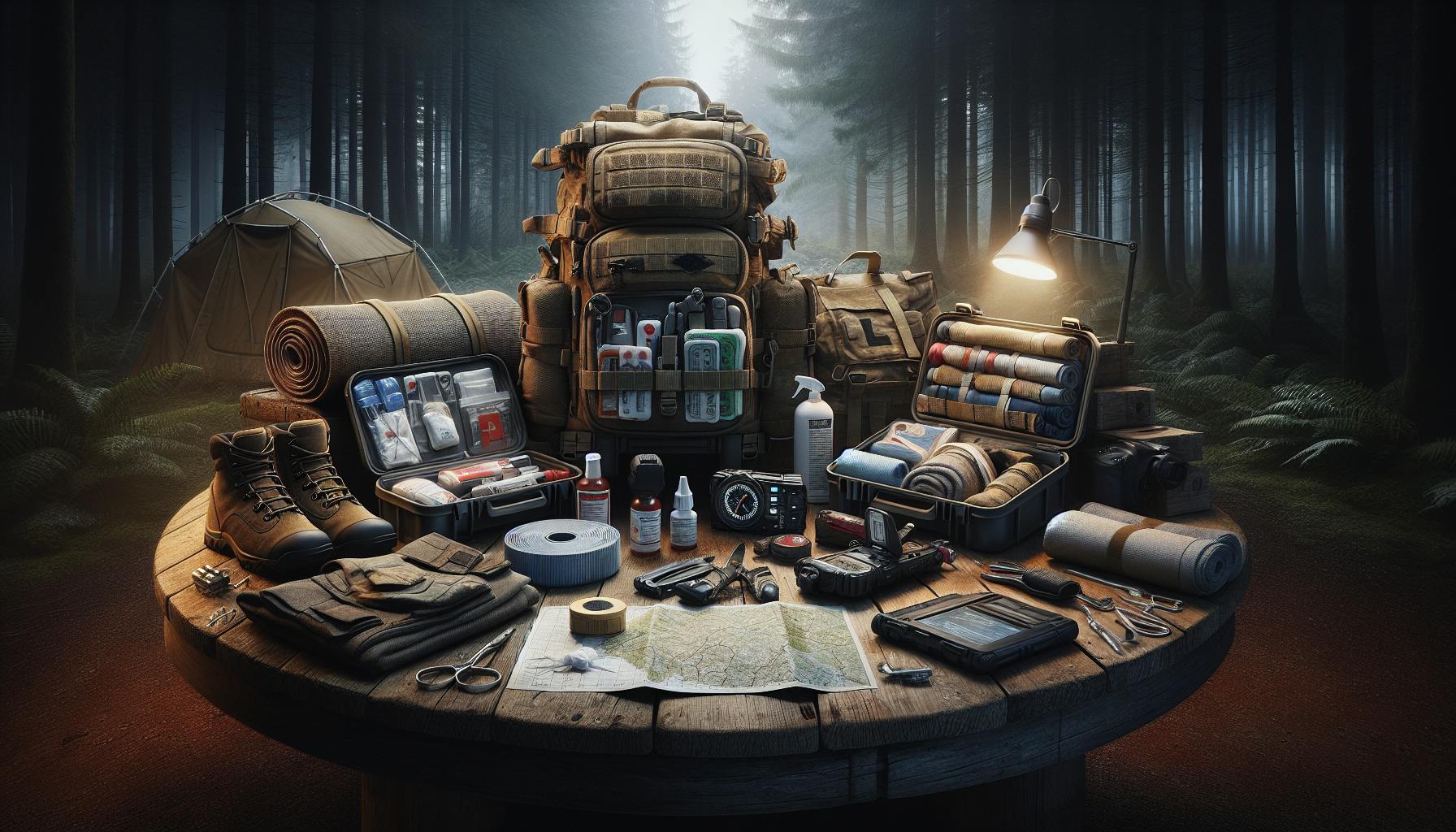Introduction to Home Prepping Essentials
Being prepared for emergencies and disasters is crucial for protecting your family and giving everyone peace of mind. Whether it's a natural disaster like a hurricane or tornado, or a man-made crisis like civil unrest or cyber attack, having a home prepping plan helps ensure your household's safety and resilience. Taking incremental steps over time to prepare makes the process more manageable. This article covers fundamental home prepping essentials that every family should implement, including supplies, skills, and knowledge to deal with a range of situations.
Emergency Survival Kits
Having well-stocked emergency kits is the cornerstone of home prepping. Essential items include:
- Water - 1 gallon per person per day for at least 14 days
- Non-perishable food - Enough calories and nutrition for 2+ weeks. Consider canned foods, freeze-dried meals, protein bars, etc.
- First aid kit - Bandages, gauze, OTC meds, gloves, trauma items
- Flashlights - Handheld, headlamps, lanterns with extra batteries
- Battery-powered or hand-crank radio
- Blankets, sleeping bags, emergency tents
- Basic tools - Knife, duct tape, rope, zip ties, multi-tool
- Sanitation supplies - Toilet paper, trash bags, baby wipes
- Cash in small bills
- Extra house and car keys
- Solar phone charger
Customize kits for your family's unique needs like medications, infant formula, pet food, etc. Maintain kits for your home, vehicles, and workplace. Check and replenish contents every 6 months. Consider waterproof containers.
Water Storage Considerations
Stored water is critical when supply lines are disrupted. Aim to have at least 1 gallon per person per day for 2 weeks minimum. Bulk storage options include 55-gallon plastic drums or 5-7 gallon plastic jerry cans. Maintain both transportable jugs and large stationary containers. Replace annually and add water stabilizing treatment. Store in cool, shaded areas like a basement or crawlspace. Have a water filter or purification method as backup.
Energy and Light Sources
Power outages are common in disasters. Have alternate renewable light and energy sources like solar-powered lanterns, rechargeable batteries, generators, and portable solar panels. Place lights strategically around the home including the attic, basement, hallways, and bathrooms. Have battery-powered tap lights in bedrooms. Safely store fuel like propane, gasoline, or diesel away from combustibles, in proper OSHA containers. Maintain a generator or solar/battery system.
Communication Equipment
When electricity and internet are down, backup communication is essential. Have a supply of charged spare batteries for mobile phones and extra wall/car chargers, including hand-cranked or solar powered chargers. Two-way radios allow local group communication within a few miles. Know how to use equipment beforehand and print out a list of emergency frequencies. Have paper maps on hand as backup.
Food Supplies for Sheltering In Place
Stockpile at least a 2 week supply of calories and nutrition focusing on long shelf-life items like rice, beans, pasta, oats, canned meats, peanut butter, protein bars, and freeze-dried camping meals. Include comfort foods as well. Track expiration dates and rotate supplies using the FIFO (First In First Out) method. Replenish as you go. Consider adding oxygen absorbers to packaging to extend shelf life.
Home Fortification and Security
Securing your home from intruders should be part of emergency plans. Start with strong locks, alarm systems, motion sensor lights and cameras as deterrents. Use window film or install reinforced doors and window guards. Keep bushes trimmed low and add thorny plants around the perimeter. Getting to know neighbors builds community strength and extra security.
Fire Safety and Prevention
Have ABC fire extinguishers placed in high risk areas like the kitchen, garage and basement. Learn proper use - remember PASS (Pull, Aim, Squeeze, Sweep). Install interconnected smoke/CO alarms on every level. Establish and practice escape routes and meeting place. Store combustibles away from heat and teach household fire safety. Conduct fire drills including evacuation. Document valuables and fireproof key documents.
Utilities and Home Systems
Know how to manually shut off utilities like electricity, gas and water in case of leaks or damage. Compare whole house standby generators vs solar panels/battery banks for backup power. Weatherproof your home, maintain appliances, and prune nearby trees. Have tools for DIY repairs. Stock extra hardware like screws, nails, glue, and tape. Ensure proper ventilation for indoor heat sources.
Sanitation and Hygiene
When infrastructure is disrupted, sanitation becomes critical. Stock several weeks' supply of trash bags, toilet paper, paper towels, baby wipes, and cleaning items like disinfectants, bleach, gloves, and masks. Manage waste properly in tied bags and dispose regularly when possible. Prevent disease by washing hands and disinfecting surfaces. Set up a temporary toilet with privacy tent using a 5-gallon bucket, garbage bags, and kitty litter or sawdust.
Storing Fuels and Firewood
For cooking and heating without power, store extra fuels and dry, seasoned firewood. Rotate fuel to keep it fresh and prevent degradation. Have a safe outdoor cooking area away from combustibles. Follow proper venting procedures for indoor heating. Stack firewood up off the ground and covered.
Tools for Repairs and Self-Reliance
Having basic tools allows you to make repairs and be self-reliant when professionals are unavailable. Essentials include a multi-tool, duct tape, work gloves, utility knife, pliers, hatchet, handsaw, hammer, shovel, broom, and wrenches. Take inventory of supplies and learn skills to employ them. YouTube tutorials are handy for DIY practice.
Skills Development and Community
Useful skills like first aid, food preservation, navigation, and communication help reduce dependency in an emergency. Take classes or use online resources to start learning. Getting involved locally builds relationships and support networks.
Emergency Medical Training
Take first aid, CPR and trauma classes through American Red Cross or American Heart Association to respond effectively when 911 is unavailable. Learn wound care, recovery position, splinting and more. Use regular practice drills to reinforce skills. Consider becoming an EMT.
Food Preservation and Preparation
Develop skills like canning, dehydrating, curing and cooking from storage without power. Take local classes or use online tutorials from sources like the National Center for Home Food Preservation. Practice cooking with your stored ingredients. Learn about raw food storage times.
Navigation and Orientation
Without digital navigation, map reading and compass skills are critical. Take classroom courses or self-teach using reputable hiking/navigation guides. Regularly practice on known routes to build proficiency. Learn to estimate distances, use terrain features as guides, and triangulate your position.
Self Defense and Fitness
Basic self defense training gives confidence to handle confrontations. Fitness endures the physical demands of survival situations. Take classes at gyms, martial arts studios, or train with outdoor groups. Test yourself with real-world practice like hiking with a pack. Set goals for strength, endurance and flexibility.
Communication Skills
Leadership and teamwork are crucial when organizing community response. Conflict resolution and public speaking skills bring people together. Seek training opportunities and practice through local groups like church or volunteer programs. Study psychology and mental health first aid.
Key Takeaways on Home Prepping Essentials
The fundamentals of home prepping involve gathering critical supplies, developing useful skills, and connecting with community. Tailor your plans to your family’s unique needs. Take incremental steps over time to increase preparedness through actionable items. Allow yourself to learn new skills continuously. Being proactive with emergency planning leads to self-reliance and peace of mind when faced with disasters. Use this article as a blueprint for essential preparations to protect your home and loved ones. Consider joining local preparation groups to expand your knowledge and support network. With research and practice, every household can implement these home prepping essentials.


